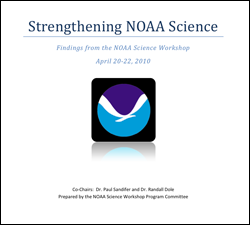
|
"Improve understanding of the water cycle" Identified as a NOAA Science "Grand Challenge"
Under the direction of NOAA's Administrator, Dr. Jane Lubchenko, the first NOAA Science Workshop was conducted in April 2010 as a part of an effort to strengthen NOAA science. It involved 70 top scientists and science managers from across the organization who thought freely about the critical science and management challenges we face now and in the next 5-20 years, and came to consensus on key issues. The result is a White Paper that outlines a set of specific grand challenges that will drive NOAA research and development over the upcoming years. These challenges have already been identified in the most recent draft of the Next Generation Strategic Plan and have been briefed to the NOAA Science Advisory Board (see full report).
This is particularly important to HMT partly because it identified "improve understanding of the water cycle" as one of a handful of grand challenges. This reflects the growing awareness in NOAA of the important role that NOAA Science plays in meeting the agency's and the nation's needs for improved knowledge and tools addressing gaps in hydrometeorological science and predictions. It is also consistent with the collaborative, cross-NOAA and multi-agency strategies employed in HMT. The following quotation is from Chapter 1 (Identifying Critical Science Challenges for NOAA) of the report:
Improve understanding of the water cycle at global to local scales to improve our ability to forecast weather, climate, water resources and ecosystem health.
According to the projections by the Intergovernmental Panel on Climate Change (IPCC), while the globally averaged precipitation may increase only by a few percent per degree of global average temperature increase, in many places precipitation intensity and drought frequency will both increase. Such changes are expected to further stress already over-strained water supply and flood control systems, making it even more critical to improve the efficiency of water resource management throughout the US and in many other parts of the world. This problem poses a considerable challenge because with current technology it is impossible to determine the composition, structure and physical properties of the subsurface (both soil and bedrock), and therefore, to develop models that accurately predict the movement of water below the Earth's surface. As the nation's agency responsible for forecasting fresh water flows, from droughts to floods, NOAA is uniquely aligned to address this challenge in cooperation with its partners for subsurface hydrology. Further, water fluxes in the atmosphere, on land and in the subsurface affect weather, climate, and hydrology, and are a key component for maintaining healthy ecosystems, fisheries, and transportation on rivers and estuaries. It is therefore imperative that NOAA emphasize improving understanding of the water cycle, across all spatial and temporal scales, and from observations to forecasts. Water managers critically need reliable short- and long-term forecasts, and developing these forecasts requires detailed understanding of water cycle processes and their implications for water resources in a changing environment."